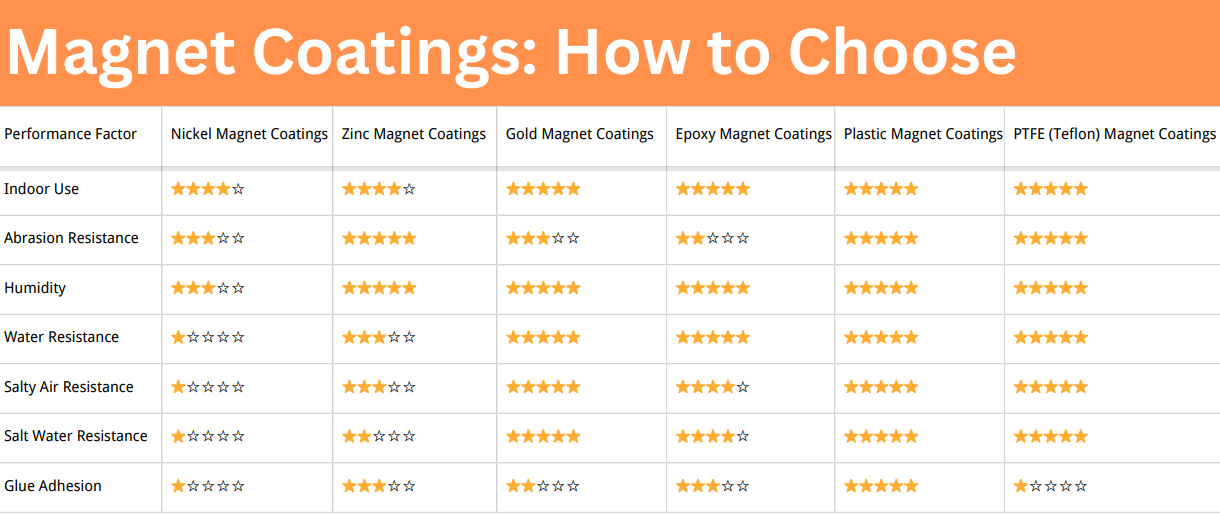List of Magnets That Can Withstand High Temperatures
Introduction
The strength of different magnets is affected by shapes, sizes, and most importantly, the ambient temperature. Therefore, it is rather significant to know about the influence of temperature on the magnetic force before selecting your magnets. Here, this article is going to discuss such influence with several examples of high-temperature resistant magnets.

magnets that can withstand high temperatures
How Can Temperature Affect Magnets?
First, let’s learn about how temperature affects magnets with some basic information.
- Cold Rather Than Hot: Generally, heat reduces the magnetic force, while cold strengthens magnetism. Magnets have a preference for cold surroundings, so using them under room temperature could work.
- Maximum Operating Temperature VS. Curie Temperature: If you heat your magnets to their maximum operating temperature, they will lose some magnetic strength irreversibly. If the ambient temperature exceeds Curie temperature, all the magnetization would be lost. Both maximum operating temperature and Curie temperature vary according to the types and grades of magnets.
- Reversible Loss VS. Irreversible Loss: Bring your magnets back down to room temperature, and reversible losses can be recovered. Nevertheless, magnets with irreversible losses can’t recover the magnetization they lose.
Magnets That Can Withstand High Temperatures
Second, let’s take a look at several strong magnets that can tolerate high temperatures. You can check the table below to find their corresponding maximum operating temperatures and Curie temperatures.
Table 1 Maximum Operating Temperatures and Curie Temperatures
| Maximum Operating Temperature/℃ | Curie Temperature/℃ | |
| Al-Ni-Co Magnet | 525 | 800 |
| Ferrite Magnet | 250 | 450 |
| Sm-Co Magnet | 310-400 | 700-800 |
| Nd-Fe-B Magnet | M (80-100), H (100-120), SH (120-150), UH (150-180), EH (180-200). | 310-400 |
1. Al-Ni-Co Magnet - 525℃
Al-Ni-Co magnets are composed of aluminum, nickel, cobalt, and iron, and these magnets possess the highest maximum operating temperature of 525℃. Thus, they are suitable for extremely high-temperature workplaces. Additionally, Al-Ni-Co magnets appeared in the market quite early. They were commercially available in the 1960s and were replaced by rare earth magnets in the 1980s. Yet, these tough magnets are still commonly used to make sensors, guitar pickups, and other high-temperature handling equipment.
Related reading: What Is an Alnico Magnet & What Is an Alnico Magnet Used for?
2. Ferrite/Ceramic Magnet - 250℃
Ferrite magnets contain a large amount of iron oxide and a small proportion of other metallic elements. Although ferrite magnets come with a relatively lower maximum operating temperature of 250℃, they are widely used because of their lower cost. They are also called ceramic magnets due to their extremely high electrical resistance. With these desirable features, ferrite magnets find various applications, such as transformers, computer cables, and so on.

Figure 2 Ferrite Magnets
3. Sm-Co Magnet - 310~400℃
Sm-Co magnets come with strong magnetic power and a maximum operating temperature ranging from 310 to 400℃. Although they are less strong than neodymium magnets, Sm-Co magnets have higher temperature ratings, making them suitable for applications involving high or extremely low temperatures. Besides, these magnets have notable properties like good oxidation resistance, corrosion resistance, and extreme demagnetization resistance. Stanford Magnets has rich experience and advanced technology in the manufacturing and supplying of samarium cobalt magnets. There are mainly two types of Sm-Co magnets (series 1:5 and series 2:17) available on our website. Send us an inquiry if you are interested.
4. Nd-Fe-B Magnet - 80~200℃
Nd-Fe-B magnets, or neodymium magnets, are the most commercially available magnet and their working temperature can reach up to 200 degrees Celsius. It is the most commercially available magnet and its working temperature can reach up to 200 degrees Celsius. Neodymium magnet is classified by temperature as M (80-100 ℃), H (100-120 ℃), SH (120-150 ℃), UH (150-180 ℃), EH (180-200 ℃). The magnetic strength of NdFeB magnets is closely related to the change in ambient temperature. Within the working temperature range, neodymium magnets lose 0.11% of their magnetism when the temperature rises by 1 ℃. After cooling, most of the magnetic force can return to the original level, which is reversible. This is irreversible if the temperature reaches Curie’s and parts of the magnet move violently and demagnetize.

Figure 3 Neodymium Magnets
Conclusion
Al-Ni-Co magnets, ferrite magnets, Sm-Co magnets, and neodymium magnets are strong magnets with impressive high-temperature resistance. But remember to check their respective maximum operating temperatures and Curie temperatures in advance. Stanford Magnets is a leading supplier of permanent magnets that can withstand high temperatures. Visit our homepage to get high-quality magnets for your home or business.














